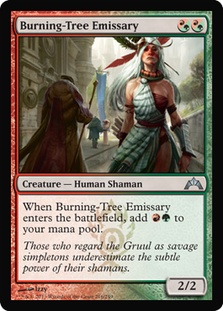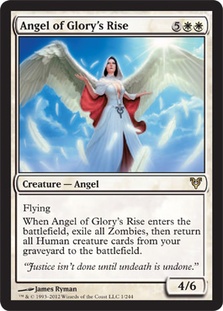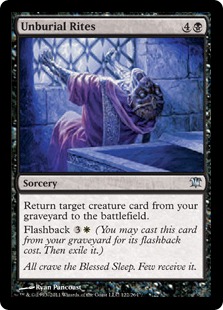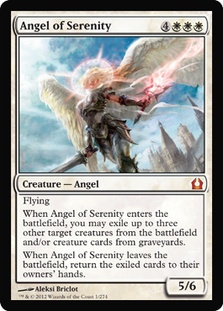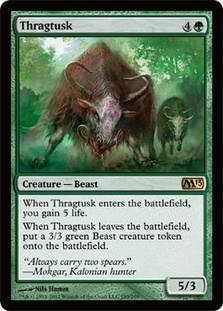O Boros Reckoner, where art thou?
What happened to our hero? The innocuous Minotaur Wizard that took Standard by storm seems to have disappeared. We used to strategically plan out our mana bases so that every land could cast the triple Boros hybrid mana monster. Drawing an Island was always a heartbreaker, let me tell you, but we did it. Hell, we had to! Cacklers and Nobles and Flinthoof Boars were everywhere! We even went as deep as playing Harvest Pyre as a combo kill so that Reckoner wasn’t worthless against the other control decks.
Creatures (14)
Lands (25)
Spells (21)

What happened?
The Humans revolted. Burning-Tree Emissary’s got a job. She’s bona fide. Reckoner, what are you? Turn 3 is too slow for a creature that almost always two for ones the opponent or, at best, stops them in their tracks. Priest of Gix never looked so good! The first shift in the format was Burning-Tree Emissary. To fully wrap your head around this, we need to take a little step back.
Boros Reckoner was everywhere—midrange Naya, U/W/R Flash, Mono-Red Aggro, Boros Aggro, Saito-style Gruul Aggro. Now, keep in mind that midrange Jund decks were around too and were putting up some good numbers, but mainly in the hands of masters like Owen Turtenwald and Reid Duke. Jund is a very good deck that can be built to be the best answer to just about any strategy at the cost of giving up matchups against something else. But this is really about Boros Reckoner.
Creatures (17)
- 4 Fiend Hunter
- 4 Huntmaster of the Fells
- 4 Angel of Glory's Rise
- 1 Cathedral Sanctifier
- 4 Cartel Aristocrat
Lands (23)
Spells (20)

Creatures (20)
- 4 Fiend Hunter
- 4 Huntmaster of the Fells
- 4 Angel of Glory's Rise
- 4 Burning-Tree Emissary
- 4 Undercity Informer
Lands (22)
Spells (18)

Then, there was the first shift. Human Reanimator came back—first with Cartel Aristocrat a la Brad Nelson and Brian Braun-Duin deck from before PT Gatecrash, and then with our little antagonist Burning-Tree Emissary. Why pass the turn to your opponent when you could just mill them out right away with Undercity Informer? The midrange Naya decks were too slow to beat it. After sideboard they could have Rest in Peace, but not everyone played it. Plus, you could just play around it and set up one big turn. Same with Flash. The aggro decks weren’t fast enough yet to beat it, and so the next step in the evolution began to happen.
Creatures (33)
- 4 Champion of the Parish
- 4 Mayor of Avabruck
- 4 Lightning Mauler
- 4 Flinthoof Boar
- 4 Boros Elite
- 4 Burning-Tree Emissary
- 4 Experiment One
- 4 Frontline Medic
- 1 Ghor-Clan Rampager
Lands (20)
Spells (7)
Sideboard

Naya Blitz was the result, again championed by one Brad Nelson. This deck pushed the envelope for aggression, taking Burning-Tree Emissary to an entirely new level. Hands that contained her, especially on the play, put the Blitz player so far ahead it was unreal. Your Blitz opponent would cast Champion of the Parish into Emissary and Lightning Mauler paired, all the while you stared at your Boros Reckoners in your hand wondering why bad things always happen to good people.
The aggressive decks doing well continued to make counterspells look bad; not that they were really any good before because of Cavern of Souls and the way most games played out, but now they were really bad. The control decks now had to plan for stabilizing and then trying to get back into it with a midsized Sphinx’s Revelation since that’s really all you need when your opponent goes so hard from the start. The problem with this is that against midrange decks, aka the “Thragtusk and Restoration Angel love affair,” you’re left with awkward situations where you can’t really come back from having to two for one yourself when they have average draws.
The next shift of the Standard metagame that took place is the most interesting one, as it attacked the new decks and the original version of these decks that caused the first evolution. Everyone seemed to forget that Angel of Serenity existed. Angel of freaking Serenity. When everyone is playing Boros Reckoner, Angel is the best endgame. When everyone is trying to go under Reckoner, Angel is your non-blue Revelation. When everyone is trying to out-value Reckoner with midrange Thragtusk / Resto crap, Angel is the best endgame. When people are trying to ignore Boros Reckoner with graveyard strategies, guess what—Angel stops that too.
Creatures (29)
- 4 Arbor Elf
- 4 Avacyn's Pilgrim
- 3 Strangleroot Geist
- 4 Restoration Angel
- 4 Thragtusk
- 4 Loxodon Smiter
- 3 Angel of Serenity
- 3 Prime Speaker Zegana
Planeswalkers (4)
Lands (24)
Spells (4)
- 4 Farseek

Creatures (24)
- 3 Arbor Elf
- 4 Avacyn's Pilgrim
- 4 Restoration Angel
- 2 Craterhoof Behemoth
- 4 Thragtusk
- 3 Angel of Serenity
- 4 Centaur Healer
Lands (23)
Spells (13)

Andrew Shrout and Brad (obviously figured this out again) Nelson saw this and implemented her in Prime Speaker Bant deck and G/W/B Reanimator. Standard is a format of diverse threats and multiple angles of attack. When things line up and a single card can help fight against so many different things, like Angel of Serenity, that’s beauty. Even though everyone’s favorite Minotaur is now being relegated to a two-of in the sideboard, the Standard format is healthy, diverse, and just about as open as you can get. So where do we go next?
First, we need to define what the popular angles of attack are. They can be broken down into four different categories:
Aggro (Naya Blitz, Naya Humans, Mono-Red/Boros Aggro, R/G Aggro)
Control (Esper, U/W/R Flash)
Reanimator (Human, G/W/B)
Midrange (Jund, Naya, Bant)
Within these archetypes, we should next take a look at what cards in each deck type are effective against the other deck types.
Naya Blitz: Burning-Tree Emissary pushes the envelope for aggression, allowing you to put out more threats than your opponents can handle on a one-for-one basis. Lightning Mauler is BTE’s partner in crime. In the sideboard, this deck can play Rest in Peace effectively against the Reanimator decks (both flavors); however, post-board these decks are more Centaur Healer / Thragtusk / Restoration Angel value decks. If you are wasting time casting Rest in Peace, they are getting back in the game. Frontline Medic gives midrange decks headaches, which is your saving grace against this line of play. The less Boros Reckoners being played, the better this type of deck becomes, but Reckoner isn’t the end of the world. This deck can be inconsistent though.
Naya Humans: Burning-Tree Emissary again is the focal point. The difference between this and the Blitz deck is that Humans eschews the high-variance cards like Experiment One and Lightning Mauler for more consistent, high-impact cards like Silverblade Paladin, Huntmaster of the Fells, and Restoration Angel. These changes make the deck better against other aggressive decks but make them more vulnerable to control decks, not being able to push through the last few bits of damage needed before Sphinx’s Revelation takes over.
Mono Red/Boros Aggro and R/G Aggro are essentially the same deck. The only difference is that one is straight Mono-Red (or splashing Boros Charm) and the other is Mono-Red splashing Rancor and Ghor-Clan Rampager. Well, that’s not the only difference. Mono-Red Aggro doesn’t use our little Human Shaman, BTE. Instead of trying to flood the board with efficient two-drops, it plans to use its one-drops to get in damage and lean on Hellrider and Boros Charm to clean up. Both of these decks aren’t very well positioned at the moment, and if you want to be aggressive and not be playing Blitz or Humans, I would recommend something along the lines of Jund Aggro or Zombies.
For control decks, Esper and U/W/R Flash, the key card is Sphinx’s Revelation. Esper will mill you with Jace or Nephalia Drownyard and Flash will attack you with Restoration Angels and Boros Reckoners, but the real win condition in both of these decks is Sphinx’s Revelation. Once they start chaining Revelations, it’s extremely tough to come back. The first Revelation for four or five will almost always find another Revelation or a Snapcaster Mage, which is effectively the same thing.
They both have different flavors of one-for-ones—Searing Spear; Mizzium Mortars; Devour Flesh; Ultimate Price; and Azorius Charm—as a bridge to get to their sweepers, Supreme Verdict and/or Planar Cleansing. Unfortunately, these decks have to have the right mix of answers to combat the differing aggressive strategies or they just die, and they are currently weak to the Reanimator decks. It’s good to note that both of these decks can play Angel of Serenity themselves as an endgame, which is bonkers against the midrange and Reanimator decks.
Speaking of Reanimator, it currently comes in two flavors. Human Reanimator utilizes Burning-Tree Shaman with Angel of Glory’s Rise; Undercity Informer; and Fiend Hunter to mill the opponent out. This is an extremely consistent turn 5 deck and can combo as early as turn 4. G/W/B Reanimator is a throwback to the old Craterhoof Behemoth Reanimator decks using Angel of Serenity; Restoration Angel; and Thragtusk as their grindy endgame. Most maindecks don’t really have ways to interact with these strategies, with the exception being that G/W/B Reanimator has Angel of Serenity to trump the Human combo deck.
The midrange decks all have one value monster in common, Thragtusk, in addition to Farseek for acceleration and fixing. Naya goes the Huntmaster of the Fells / Restoration Angel route, Jund goes the Huntmaster of the Fells / Olivia Voldaren route, and Bant goes with Restoration Angel / Prime Speaker Zegana / Angel of Serenity and some planeswalkers. Naya also gets Bonfire of the Damned and/or Mizzium Mortars along with Jund, who also gets Liliana of the Veil and Rakdos’s Return, which is crazy good against the other midrange and control decks. Angel of Serenity out of the Bant deck gives it an edge against the Reanimator decks and the other midrange decks.
If you made it all the way through those explanations, you may see some trends.
The aggressive decks mainly play Burning-Tree Emissary and/or Boros Charm and are weak to spot removal backed with Thragtusk / Angel strategies.
The control decks all have Sphinx’s Revelation and an assorted mix of one-for-ones and are weak to the aggressive decks with awkward draws, struggle against the midrange decks with Thragtusk, are weak to Rakdos’s Return, and have to work to make their Reanimator matchups acceptable.
The Reanimator decks are weak to Rest in Peace, and Angel of Serenity is extremely effective against them.
The midrange decks are weak to Rakdos’s Return, and Angel of Serenity is very effective against them.
Taking all this into account, in a perfect world, I’d want to play something with Thragtusk, Restoration Angel, Angel of Serenity, and Rakdos’s Return and to not be vulnerable to my own Rest in Peaces in the sideboard. That’s a pretty demanding list of cards; fortunately, we’re back in Ravnica where the mana flows freely if you’re willing to pay the price.
As I’m writing this, I’m planning to travel to South Carolina with BBD for a PTQ this weekend. I’m still not 100% sure what I’m going to be playing, but it will more than likely have most if not all the above cards we determined we’re going to need to fight the masses! As for our friend, Boros Reckoner, don’t fret—rest assured he’ll meet you on God’s golden shore.

